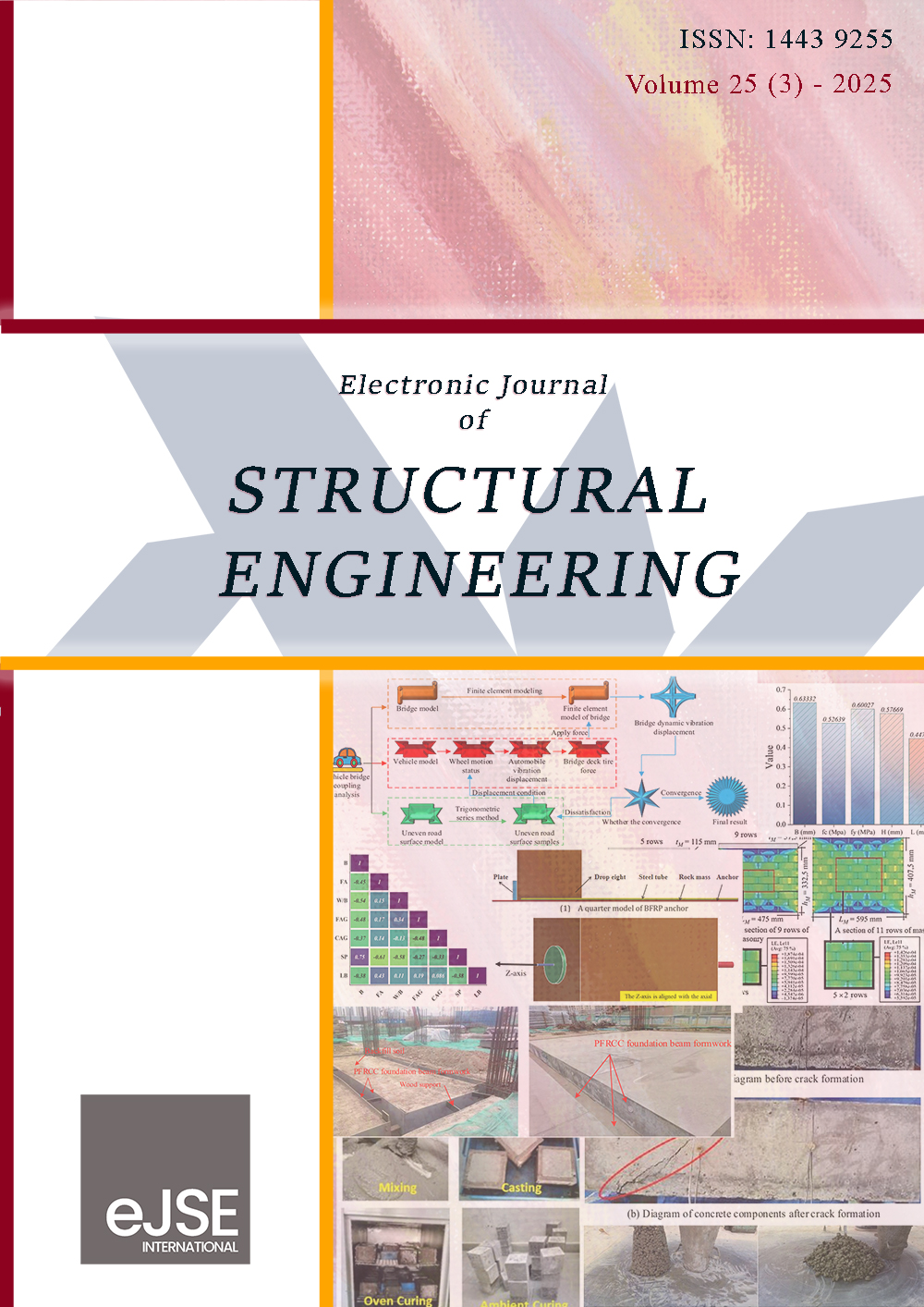Evaluation of the Rheological Properties of SCC Using Hybrid Random Forest Methods
DOI:
https://doi.org/10.56748/ejse.24791Keywords:
self-compacting concrete, fly ash, rheological properties, CS, random forestsAbstract
It is understood from the literature that limited researches were focusing on predicting both new or toughened characteristics of self-compacting concrete (SCC). Therefore, using the optimized Random Forests (RF) approach, it is tried to create some schemes to anticipate the new and toughened characteristics of SCC. The RF method's determinative variables are optimized by artificial hummingbird optimization (AHA) and grey wolf optimization (GWO) methods. The L-box test, V-funnel test, slump flow, and compressive strength (CS) in the toughened stage are taken into account attributes of SCC in the new stage. Outcomes show strong promise in both training and testing, as well as approximation. It denotes good precision in the training and approximation processes since the relationship among the measured and anticipated SCC qualities from hybrid schemes is satisfactory. Outcomes from AHA-RF outperformed those from GWO-RF and the literature. Generally, the AHA-developed RF scheme serves better than others, demonstrating the AHA tactic's capacity to choose the best variables for the under-consideration technique.
Downloads
References
Acharya, P. K., & Patro, S. K. (2015). Effect of lime and ferrochrome ash (FA) as partial replacement of cement on strength, ultrasonic pulse velocity and permeability of concrete. Construction and Building Materials, 94, 448–457. DOI: https://doi.org/10.1016/j.conbuildmat.2015.07.081
Aggarwal, Y., & Aggarwal, P. (2011). Prediction of compressive strength of SCC containing bottom ash using artificial neural networks. International Journal of Mathematical and Computational Sciences, 5(5), 762–767.
Aljarah, I., Faris, H., Mirjalili, S., & Al-Madi, N. (2018). Training radial basis function networks using biogeography-based optimizer. Neural Computing and Applications, 29(7), 529–553. DOI: https://doi.org/10.1007/s00521-016-2559-2
Bardhan, A., & Asteris, P. G. (2023). Application of hybrid ANN paradigms built with nature inspired meta-heuristics for modelling soil compaction parameters. Transp Geotech 41: 100995. DOI: https://doi.org/10.1016/j.trgeo.2023.100995
Beycioğlu, A., & Aruntaş, H. Y. (2014). Workability and mechanical properties of self-compacting concretes containing LLFA, GBFS and MC. Construction and Building Materials, 73, 626–635. DOI: https://doi.org/10.1016/j.conbuildmat.2014.09.071
Bi, Y., & Yi, Y. (2024). Application of a comparative analysis of random forest programming to predict the strength of environmentally-friendly geopolymer concrete. Steel and Composite Structures, 50(4), 443–458.
Bingöl, A. F., & Tohumcu, İ. (2013). Effects of different curing regimes on the compressive strength properties of self compacting concrete incorporating fly ash and silica fume. Materials & Design, 51, 12–18. DOI: https://doi.org/10.1016/j.matdes.2013.03.106
Breiman, L. (2001). Random forests. Machine Learning, 45(1), 5–32. DOI: https://doi.org/10.1023/A:1010933404324
Debnath, P., & Dey, A. K. (2018). Prediction of bearing capacity of geogrid-reinforced stone columns using support vector regression. International Journal of Geomechanics, 18(2), 4017147. DOI: https://doi.org/10.1061/(ASCE)GM.1943-5622.0001067
Dehghanbanadaki, A., Khari, M., Amiri, S. T., & Armaghani, D. J. (2021). Estimation of ultimate bearing capacity of driven piles in c-φ soil using MLP-GWO and ANFIS-GWO models: a comparative study. Soft Computing, 25, 4103–4119. DOI: https://doi.org/10.1007/s00500-020-05435-0
Dhiyaneshwaran, S., Ramanathan, P., Baskar, I., & Venkatasubramani, R. (2013). Study on durability characteristics of self-compacting concrete with fly ash. Jordan Journal of Civil Engineering, 7(3), 342–352.
Douma, O. B., Boukhatem, B., Ghrici, M., & Tagnit-Hamou, A. (2017). Prediction of properties of self-compacting concrete containing fly ash using artificial neural network. Neural Computing and Applications, 28(1), 707–718. DOI: https://doi.org/10.1007/s00521-016-2368-7
Esmaeili Falak, M., Sarkhani Benemaran, R., & Seifi, R. (2020). Improvement of the Mechanical and Durability Parameters of Construction Concrete of the Qotursuyi Spa. Concrete Research, 13(2), 119–134.
falak, M. E., & Benmaran, R. S. (2024). Ensemble Extreme Gradient Boosting based models to predict the bearing capacity of micropile group. Applied Ocean Research, 151. DOI: https://doi.org/10.1016/j.apor.2024.104149
Farrar, D. E., & Glauber, R. R. (1967). Multicollinearity in regression analysis: the problem revisited. The Review of Economic and Statistics, 92–107. DOI: https://doi.org/10.2307/1937887
Garcia-Troncoso, N., Li, L., Cheng, Q., Mo, K. H., & Ling, T.-C. (2021). Comparative study on the properties and high temperature resistance of self-compacting concrete with various types of recycled aggregates. Case Studies in Construction Materials, 15, e00678. DOI: https://doi.org/10.1016/j.cscm.2021.e00678
Gettu, R., Izquierdo, J., Gomes, P. C. C., & Josa, A. (2002). Development of high-strength self-compacting concrete with fly ash: a four-step experimental methodology. Proc. 27th Conf. on Our World in Concrete & Structures, CI-Premier Pte. Ltd., Eds. CT Tam, DWS Ho, P. Paramasivam y TH Tan, Singapore, 217–224.
Golafshani, E. M., & Pazouki, G. (2018). Predicting the compressive strength of self-compacting concrete containing fly ash using a hybrid artificial intelligence method. Computers and Concrete, 22(4), 419–437.
Guangyao, D., Songmin, L., Xiaoling, W., Yazhi, Z., & Qihang, W. (2024). Optimal design of ecological concrete mix proportion based on AHP-GWO-BP neural network. International Journal of Environmental Research, 18(2), 24. DOI: https://doi.org/10.1007/s41742-023-00562-6
Güneyisi, E., Gesoğlu, M., & Özbay, E. (2010). Strength and drying shrinkage properties of self-compacting concretes incorporating multi-system blended mineral admixtures. Construction and Building Materials, 24(10), 1878–1887. DOI: https://doi.org/10.1016/j.conbuildmat.2010.04.015
Han, H., Jahed Armaghani, D., Tarinejad, R., Zhou, J., & Tahir, M. M. (2020). Random forest and bayesian network techniques for probabilistic prediction of flyrock induced by blasting in quarry sites. Natural Resources Research, 29(2), 655–667. DOI: https://doi.org/10.1007/s11053-019-09611-4
Jalal, M., Pouladkhan, A., Harandi, O. F., & Jafari, D. (2015). Comparative study on effects of Class F fly ash, nano silica and silica fume on properties of high performance self compacting concrete. Construction and Building Materials, 94, 90–104. DOI: https://doi.org/10.1016/j.conbuildmat.2015.07.001
Kalemci, E. N., İkizler, S. B., Dede, T., & Angın, Z. (2020). Design of reinforced concrete cantilever retaining wall using Grey wolf optimization algorithm. Structures, 23, 245–253. DOI: https://doi.org/10.1016/j.istruc.2019.09.013
Kaveh, A., Bakhshpoori, T., & Hamze-Ziabari, S. M. (2018). M5’and Mars based prediction models for properties of self-compacting concrete containing fly ash. Periodica Polytechnica Civil Engineering, 62(2), 281–294. DOI: https://doi.org/10.3311/PPci.10799
Kostić, S., & Vasović, D. (2015). Prediction model for compressive strength of basic concrete mixture using artificial neural networks. Neural Computing and Applications, 26(5), 1005–1024. DOI: https://doi.org/10.1007/s00521-014-1763-1
Krishnapal, P., Yadav, R. K., & Rajeev, C. (2013). Strength characteristics of self compacting concrete containing fly ash. Res J Eng Sci ISSN, 2278, 9472.
Liu, D. (2025). Application of tuned random forests model on cement paste including fly ash and MgO expansive additive. Multiscale and Multidisciplinary Modeling, Experiments and Design, 8(1), 1–18. DOI: https://doi.org/10.1007/s41939-024-00651-9
Liu, J., Yan, K., Zhao, X., & Hu, Y. (2016). Prediction of autogenous shrinkage of concretes by support vector machine. International Journal of Pavement Research and Technology, 9(3), 169–177. DOI: https://doi.org/10.1016/j.ijprt.2016.06.003
Mahalingam, B., & Nagamani, K. (2011). Effect of processed fly ash on fresh and hardened properties of self compacting concrete. Int J Earth Sci Eng, 4(5), 930–940.
Mirjalili, S., Mirjalili, S. M., & Lewis, A. (2014). Grey wolf optimizer. Advances in Engineering Software, 69, 46–61. DOI: https://doi.org/10.1016/j.advengsoft.2013.12.007
Muthupriya, P., Sri, P. N., Ramanathan, M. P., & Venkatasubramani, R. (2012). Strength and workability character of self compacting concrete with GGBFS, FA and SF. Int J Emerg Trends Eng Dev, 2(2), 424–434.
Naseri, F., Jafari, F., Mohseni, E., Tang, W., Feizbakhsh, A., & Khatibinia, M. (2017). Experimental observations and SVM-based prediction of properties of polypropylene fibres reinforced self-compacting composites incorporating nano-CuO. Construction and Building Materials, 143, 589–598. DOI: https://doi.org/10.1016/j.conbuildmat.2017.03.124
Nepomuceno, M. C. S., Pereira-de-Oliveira, L. A., & Lopes, S. M. R. (2014). Methodology for the mix design of self-compacting concrete using different mineral additions in binary blends of powders. Construction and Building Materials, 64, 82–94. DOI: https://doi.org/10.1016/j.conbuildmat.2014.04.021
Özcan, F., Atiş, C. D., Karahan, O., Uncuoğlu, E., & Tanyildizi, H. (2009). Comparison of artificial neural network and fuzzy logic models for prediction of long-term compressive strength of silica fume concrete. Advances in Engineering Software, 40(9), 856–863. DOI: https://doi.org/10.1016/j.advengsoft.2009.01.005
Patel, R. (2004). Development of statistical models to simulate and optimize self-consolidating concrete mixes incorporating high volumes of fly ash.
Pazouki, G., Golafshani, E. M., & Behnood, A. (2021). Predicting the compressive strength of self‐compacting concrete containing Class F fly ash using metaheuristic radial basis function neural network. Structural Concrete. DOI: https://doi.org/10.1002/suco.202000047
Rashedi, K. A., Ismail, M. T., Hamadneh, N. N., Wadi, S., Jaber, J. J., & Tahir, M. (2021). Application of Radial Basis Function Neural Network Coupling Particle Swarm Optimization Algorithm to Classification of Saudi Arabia Stock Returns. Journal of Mathematics, 2021. DOI: https://doi.org/10.1155/2021/5593705
Saha, P., Debnath, P., & Thomas, P. (2020). Prediction of fresh and hardened properties of self-compacting concrete using support vector regression approach. Neural Computing and Applications, 32(12), 7995–8010. DOI: https://doi.org/10.1007/s00521-019-04267-w
Saha, P., Sapkota, S. C., Das, S., & Kwatra, N. (2024). Prediction of fresh and hardened properties of self-compacting concrete using ensemble soft learning techniques. Multiscale and Multidisciplinary Modeling, Experiments and Design, 7(5), 4923–4945. DOI: https://doi.org/10.1007/s41939-024-00423-5
Şahmaran, M., Yaman, İ. Ö., & Tokyay, M. (2009). Transport and mechanical properties of self consolidating concrete with high volume fly ash. Cement and Concrete Composites, 31(2), 99–106. DOI: https://doi.org/10.1016/j.cemconcomp.2008.12.003
Sfikas, I. P., Badogiannis, E. G., & Trezos, K. G. (2014). Rheology and mechanical characteristics of self-compacting concrete mixtures containing metakaolin. Construction and Building Materials, 64, 121–129. DOI: https://doi.org/10.1016/j.conbuildmat.2014.04.048
Shadi, R., & Nazari, A. (2019). RETRACTED ARTICLE: Predicting the effects of nanoparticles on early age compressive strength of ash-based geopolymers by artificial neural networks. Neural Computing & Applications, 31, 743–750. DOI: https://doi.org/10.1007/s00521-012-1085-0
Shariati, M., Mafipour, M. S., Ghahremani, B., Azarhomayun, F., Ahmadi, M., Trung, N. T., & Shariati, A. (2020). A novel hybrid extreme learning machine–grey wolf optimizer (ELM-GWO) model to predict compressive strength of concrete with partial replacements for cement. Engineering with Computers, 1–23. DOI: https://doi.org/10.1007/s00366-020-01081-0
Siddique, R., Aggarwal, P., & Aggarwal, Y. (2012). Influence of water/powder ratio on strength properties of self-compacting concrete containing coal fly ash and bottom ash. Construction and Building Materials, 29, 73–81. DOI: https://doi.org/10.1016/j.conbuildmat.2011.10.035
Sonebi, M., Cevik, A., Grünewald, S., & Walraven, J. (2016). Modelling the fresh properties of self-compacting concrete using support vector machine approach. Construction and Building Materials, 106, 55–64. DOI: https://doi.org/10.1016/j.conbuildmat.2015.12.035
Subaşı, S., Beycioğlu, A., Sancak, E., & Şahin, İ. (2013). Rule-based Mamdani type fuzzy logic model for the prediction of compressive strength of silica fume included concrete using non-destructive test results. Neural Computing and Applications, 22(6), 1133–1139. DOI: https://doi.org/10.1007/s00521-012-0879-4
Sukumar, B., Nagamani, K., & Raghavan, R. S. (2008). Evaluation of strength at early ages of self-compacting concrete with high volume fly ash. Construction and Building Materials, 22(7), 1394–1401. DOI: https://doi.org/10.1016/j.conbuildmat.2007.04.005
Taffese, W. Z., & Nunes, S. (n.d.). MACHINE LEARNING-BASED PREDICTION OF SCC MORTAR PROPERTIES ACROSS VARIOUS CEMENT TYPES.
Tunca, O. (2024). Effect of the soil slope on the cost-efficient optimum discrete design of reinforced concrete isolated footings. Structures, 59, 105769. DOI: https://doi.org/10.1016/j.istruc.2023.105769
Uysal, M., & Yilmaz, K. (2011). Effect of mineral admixtures on properties of self-compacting concrete. Cement and Concrete Composites, 33(7), 771–776. DOI: https://doi.org/10.1016/j.cemconcomp.2011.04.005
Wang, J., Dai, Q., & Si, R. (2022). Experimental and Numerical Investigation of Fracture Behaviors of Steel Fiber–Reinforced Rubber Self-Compacting Concrete. Journal of Materials in Civil Engineering, 34(1), 4021379. DOI: https://doi.org/10.1061/(ASCE)MT.1943-5533.0004010
Yang, H. Y., & Dong, Y. F. (2013). Modelling concrete strength using support vector machines. Applied Mechanics and Materials, 438, 170–173. DOI: https://doi.org/10.4028/www.scientific.net/AMM.438-439.170
Yang, S., Fang, C. Q., & Yuan, Z. J. (2014). Study on mechanical properties of corroded reinforced concrete using support vector machines. Applied Mechanics and Materials, 578, 1556–1561. DOI: https://doi.org/10.4028/www.scientific.net/AMM.578-579.1556
Yazdi, J. S., Kalantary, F., & Yazdi, H. S. (2013). Prediction of elastic modulus of concrete using support vector committee method. Journal of Materials in Civil Engineering, 25(1), 9–20. DOI: https://doi.org/10.1061/(ASCE)MT.1943-5533.0000507
Yoo, S.-W., Ryu, G.-S., & Choo, J. F. (2015). Evaluation of the effects of high-volume fly ash on the flexural behavior of reinforced concrete beams. Construction and Building Materials, 93, 1132–1144. DOI: https://doi.org/10.1016/j.conbuildmat.2015.05.021
Yunpeng, L., Shenghuan, D., Yingbin, J., & Yuqian, M. (2024). Estimation of pile-bearing capacity applying hybrid auto-regressed models based on regression decision tree. Multiscale and Multidisciplinary Modeling, Experiments and Design, 7(3), 2225–2239. DOI: https://doi.org/10.1007/s41939-023-00330-1
Zhao, W., Wang, L., & Mirjalili, S. (2022). Artificial hummingbird algorithm: A new bio-inspired optimizer with its engineering applications. Computer Methods in Applied Mechanics and Engineering, 388, 114194. DOI: https://doi.org/10.1016/j.cma.2021.114194
Downloads
Published
How to Cite
Issue
Section
License
Copyright (c) 2025 Junsong Wang

This work is licensed under a Creative Commons Attribution 4.0 International License.







